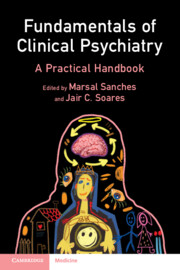This book aims at providing the reader with an introduction to psychiatry and to the study of mental disorders. While still addressing basic theoretical concepts of importance for the understanding of psychiatry as a specific field of knowledge, its main focus is not an extensive discussion or a comprehensive review of research findings. Instead, whenever possible, the different topics are addressed from a practical point of view, allowing the reader not only to expand their base knowledge but, most importantly, to obtain a good picture of how patients experiencing these conditions usually present themselves in clinical contexts. Moreover, the treatment of mental disorders is addressed in an objective, straightforward way, based on the respective authors’ own clinical experience in the management of a high number of patients, in different settings.
The chapters are sorted into two distinct portions. The first half of the book (Chapters 2–15) comprises general topics of interest for psychiatrist and mental health workers. Themes such as the psychiatric interview, psychopathology and the mental status exam, diagnostic and classification in psychiatry, and introduction to psychosocial aspects of psychiatric care, along with the biological basis of mental illnesses, are provided. Specific chapters focusing on transcultural and ethico-legal aspects of psychiatry, as well as the practice of psychiatry in special populations (children and adolescents, geriatric patients, and women in reproductive age), are also included. Two chapters address biological treatments in psychiatry (psychopharmacology and neurostimulation techniques). The last two chapters of this section focus on suicide and psychomotor agitation utilizing a syndromic approach, given the importance of these conditions in psychiatric practice and their transdiagnostic nature.
In contrast, Chapters 16–32 address specific conditions or groups of disorders most commonly seen in psychiatric practice. Most chapters in this portion of the book are organized in the same way, with different sections contemplating general considerations, pathophysiological aspects, clinical presentation, and therapeutic aspects of each disorder or groups of disorders. Nonetheless, in the description of clinical features and diagnostic considerations, the contributors were given full discretion to utilize a more systematic, criteria-based approach (according to contemporary international classifications) or to use a more generic clinical framework, based on their own preference and the approach usually adopted by them in their respective daily practices. Despite the popularity and importance of systematic classifications in psychiatry, the goal of this book is not to provide a comprehensive list of diagnostic categories and criteria for every single condition hereby discussed, and the reader primarily interested in detailed information on such criteria should consult specific diagnostic manuals or books primarily focused on systematic classifications of mental illnesses [1–Reference Tyrer3].
Last, despite all the efforts made by the authors in providing accurate and up-to-date information in the present book, the field of psychiatry is constantly evolving. The authors, editors, and publisher make no warranties that the information included in this book is totally free from error. The data included in this book with regards to the diagnosis and management of patients with mental disorders (including medication risks, benefits, and side effects) are not meant to be comprehensive, and providers should consider consulting additional resources (including information provided by manufacturers, in the case of medications) before making treatment decisions. Ultimately, providers carry the responsibility for treatment decisions made in the management of patients under their care, and the authors, editors, and publisher disclaim any responsibility for the continued currency of this information and disclaim all liability for any and all damages (including direct or consequential damages) that might result from the use of information contained in this book.

